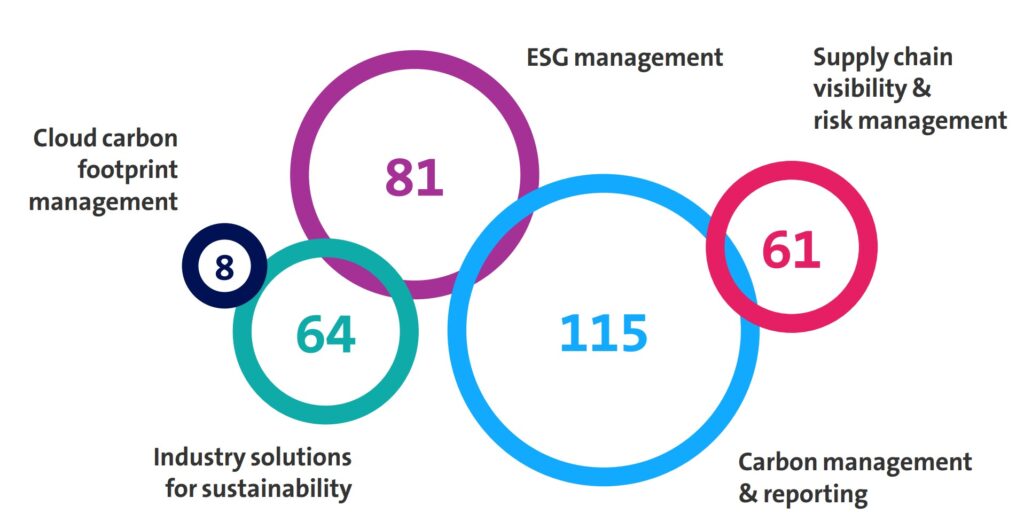How can companies reconcile sustainability, innovation and competitiveness? The more complex the requirements, the more important it is to choose the right software. The Sustainability Software Radar offers advice and recommendations. But the first step towards data-driven sustainability has nothing to do with technology.
Sustainability Software Radar
Make sustainability transparent and get a comprehensive overview of data-driven carbon management solutions with our Sustainability Software Radar.
The whole area of sustainable corporate governance has long been a consideration at boardroom level. There is growing demand among customers for eco-friendly and socially compatible products and supply chains, while investors want to know precisely who they are giving their money to. It is therefore incumbent upon companies to expand the scope of their business reporting in order to ensure transparency across the three sustainability dimensions of environment, social affairs and corporate governance (ESG).
Above all, however, policy-makers are exerting pressure through regulatory requirements: in terms of climate protection, for example, Switzerland has committed to a 2050 net-zero target and placed an obligation on business to draw up corresponding roadmaps for reducing CO₂ emissions. New rules on non-financial reporting have also been in force since 2022, including due diligence requirements in the risk analysis of supply chains in areas such as human rights, corruption and child labour. The new EU Corporate Sustainability Reporting Directive (CSRD) also indirectly affects the majority of Swiss companies. As suppliers, they must report on their sustainability risks and the measures taken in much more detail than under current Swiss law. In many cases, their customers in the EU already demand ESG indicators.
Carbon management as a software challenge
Companies are therefore faced with the challenge of establishing sustainability and carbon management and fulfilling their reporting obligations, which often vary depending on their size and sector. Preparing a climate assessment that complies with standards and includes all direct and indirect emissions along a company’s value chain (Scope 1, 2 and 3) is quite an undertaking for some management teams.
To further communicate a net-zero target under the SBTi (Science Based Targets initiative) framework, companies must be able to plan, manage and implement suitable decarbonisation measures. In most cases, an Excel spreadsheet is no longer sufficient to meet these increasing demands. A software solution is needed. But which one? Many Swiss companies are struggling to answer this question.
The benefit of carbon management software
Ceconet AG from Mägenwil (AG), a Swisscom supplier, found itself in this situation. After examining various solutions, it decided on a tool developed by a French start-up that had two advantages: ‘It shows exactly the hotspots for CO₂ emissions within our company. We can also use the tool to simulate exactly the progress we need to make on lowering emissions in order to reach our 2050 climate target,’ says Ceconet CEO Peter Bachmann.
Peter Bachmann has discovered that packaging is an important driver of emissions – and found a solution. The previous plastic packaging used for the connection cables supplied by Ceconet has been eliminated, reducing transport weight and CO₂ emissions. And the cable labels are now made of an FSC-certified material. ‘We can automatically make the relevant data available to our customers,’ explains Bachmann. This ability to provide information is important if suppliers are to compete in the long term.
The software introduced by Ceconet is just one of many sustainability tools. The market has evolved dynamically in recent years and comprises more than 200 providers, including 34 from Switzerland, with different focus areas such as carbon management, ESG reporting and supply chain visibility. Companies can thereby track every part of the supply chain, from raw materials to customers. In addition, there are ESG and sustainability solutions tailored to the specific needs of individual sectors.
Gain an overview with the Sustainability Software Radar
Companies are faced with a dizzying array of choices: not only the focus areas, but also the service portfolios and profiles of the providers vary considerably. They include start-ups and new Software-as-a-Service companies, established ESG software providers and global corporations. Together with the IT consulting firm Atlantic Ventures, Swisscom has now investigated this confusing landscape and created a navigation aid for selecting the appropriate software solution: the Sustainability Software Radar. This offers in-depth insights, gives concrete tips and introduces selected suppliers.

The Sustainability Software Radar came about in no small part because of Swisscom’s own needs. After realising that Excel was not enough to compulsorily identify and track sustainability measures, management set out to find a suitable tool. More than 30 software solutions were analysed in depth, which at the same time allowed the company to expand its own knowledge. Swisscom is now sharing what it has learned, combined with extensive experience in IT and digitalisation, with other companies in the Sustainability Software Radar, to which it has also added expert tips.
In a nutshell: the new generation of climate and sustainability management solutions is cloud-based and suitable for holistic sustainability management that covers both carbon and ESG management along the entire value and supply chain.
Ultimately, it is important that the data output by such tools can be flexibly managed so that companies can meet the requirements of sustainability standards and their metrics, such as the Greenhouse Gas (GHG) Protocol. Gina Obrecht, business developer for data-driven sustainability at Swisscom Business Customers, emphasises: ‘When engaging in this kind of forward-looking carbon and sustainability management, it is important to heed the advice of specialists and ensure close, smooth cooperation between your company’s sustainability managers on the one hand and corporate IT experts on the other.’
Sustainability Software Radar
Do you need to implement ESG reporting, but lack clarity about carbon management and the available software solutions? With our Sustainability Software Radar, you can regain an overview and take an important step towards data-driven sustainability management.
Data-driven sustainability checklist
ESG managers and IT experts should therefore work closely together on tool selection, software implementation and data integration. But how should companies go about this? As a first step, it’s worth taking stock of how things stand. It’s also necessary to clarify which regulatory standards the company is subject to, what the core requirements consist of and how ambitious the respective sustainability goals really are.
The next step is to select appropriate providers and their products. The Sustainability Software Radar provides an evaluation grid with eight criteria and numerous sub-points for this. This helpful checklist also looks at information and data security questions, as well as demanding performance criteria such as scenario and potential analyses with the help of AI.
When choosing a suitable provider, companies should think beyond the present. ‘Sustainable business development is mainly about new process solutions and product innovations that need to be managed,’ says Carlo Velten, founder and Managing Partner of Atlantic Ventures. It’s important to establish a sustainable IT setup with a strategic vision.
Recommendations for managers
- Sustainability is a top-level consideration: the first step on the road to carbon management is a clear commitment by management to net-zero thinking.
- Before a software decision is made, companies should take stock of their present situation. This is the only way they can know which tool requirements are really relevant to them.
- Transformation to a net-zero company requires innovation – a long-term strategic task. From this point of view, it’s important to identify the best possible software support.
- A company can only successfully transform with the full engagement of all employees. In particular, IT and ESG teams need to work closely together to achieve this.
Revised version of an article that first appeared on Sustainable Switzerland.



